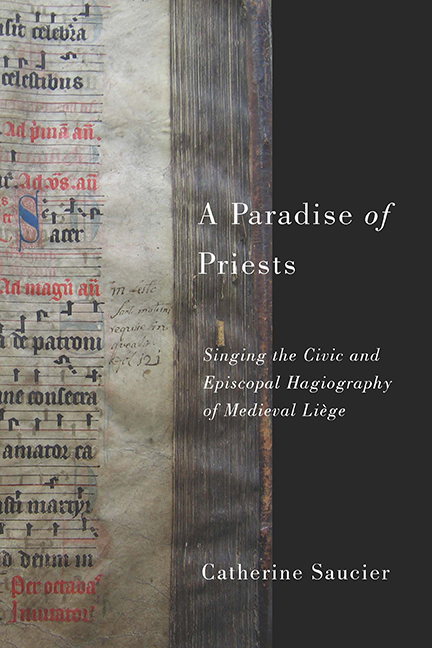Book contents
- Frontmatter
- Dedication
- Contents
- List of Illustrations
- Acknowledgments
- Abbreviations
- Note on Editorial Conventions
- Introduction: The Sound of Civic Sanctity in the Priestly Paradise of Liège
- 1 Martyred Bishops and Civic Origins: Promoting the Clerical City
- 2 The Intersecting Cults of Saints Theodard and Lambert: Validating Bishops as Martyrs
- 3 The Civic Cult of Saint Hubert: Venerating Bishops as Founders
- 4 Clerical Concord, Disharmony, and Polyphony: Commemorating Bishop Notger's City
- 5 Military Triumph, Civic Destruction, and the Changing Face of Saint Lambert's Relics: Invoking the Defensor Patriae
- Conclusion: Hearing Civic Sanctity
- Appendix: Service Books Preserving the Medieval Chant Repertory Sung in the City of Liège
- Notes
- Bibliography
- Index
5 - Military Triumph, Civic Destruction, and the Changing Face of Saint Lambert's Relics: Invoking the Defensor Patriae
Published online by Cambridge University Press: 15 March 2018
- Frontmatter
- Dedication
- Contents
- List of Illustrations
- Acknowledgments
- Abbreviations
- Note on Editorial Conventions
- Introduction: The Sound of Civic Sanctity in the Priestly Paradise of Liège
- 1 Martyred Bishops and Civic Origins: Promoting the Clerical City
- 2 The Intersecting Cults of Saints Theodard and Lambert: Validating Bishops as Martyrs
- 3 The Civic Cult of Saint Hubert: Venerating Bishops as Founders
- 4 Clerical Concord, Disharmony, and Polyphony: Commemorating Bishop Notger's City
- 5 Military Triumph, Civic Destruction, and the Changing Face of Saint Lambert's Relics: Invoking the Defensor Patriae
- Conclusion: Hearing Civic Sanctity
- Appendix: Service Books Preserving the Medieval Chant Repertory Sung in the City of Liège
- Notes
- Bibliography
- Index
Summary
Saint Lambert was extolled in the later Middle Ages not only as a virtuous martyr, but as an equally vigorous protector. In a brief allusion to the auspicious significance of the saint's name, the tenth-century author of the Carmen desancto Landberto interpreted “Landbert” to mean “defender of the patria” (defensorpatriae). Thus by name alone, Lambert could be summoned to protect his fatherland—an etymological association that proved especially effective in times of war. Indeed, the joint protective and patriotic significance of the saint's identity became literally “embodied” in his relics, through their veneration on the battlefield by local troops fighting to reclaim church land or to defend the city and diocese from external enemies. The military vigor of Lambert's relics was especially prominent at the battles of Bouillon (1141) and Steppes (1213), victories that gained liturgical commemoration on the feasts of Lambert's Translation (from 1143) and Triumph (1219). Thus, the bodily remains of this martyred bishop provided physical protection not only to the episcopal city sanctified by his martyrdom, but to the troops under the bishop's command.
Lambert's demonstrated military vigor was first recorded in hagiographic sources. Beginning with the Vita prima (727–43) and culminating with the vitae of Sigebert of Gembloux (ca. 1070–81), hagiographers consistently portrayed Lambert as a vigorous fighter. The Vita prima, echoed by Sigebert, characterizes the youthful Lambert as “strong and swift, agile, and greatly powerful in war” (fortis & velox, agilis & multum firmus in bello). Such emphasis on Lambert's martial attributes reflects the seventh- and eighth-century fusion of aristocratic and hagiographic ideals, resulting in a new type of saint who was as zealous in politics as in religion. Indeed, these hagiographers were careful to balance Lambert's vigor with his virtue. Inspired by the Vita prima, Sigebert describes the adolescent Lambert as equally “filled with charity, girded with chastity, [and] grounded in humility” (charitate plenus, castitate praecinctus, fundatus inhumilitate). Similar dualities appear in the depiction of Lambert's martyrdom. Hagiographers agree that the bishop's first impulse when confronted by his attackers was that of “the strongest warrior”—to seize a sword, ready to fight. Yet Lambert quickly drops his weapon, preferring instead to die for God. While Lambert's priest-like piety ultimately triumphs over his warrior-like agility, hagiographic emphasis on these dual attributes inspired the many faces of Lambert's virtus.
- Type
- Chapter
- Information
- A Paradise of PriestsSinging the Civic and Episcopal Hagiography of Medieval Liège, pp. 168 - 201Publisher: Boydell & BrewerPrint publication year: 2014

